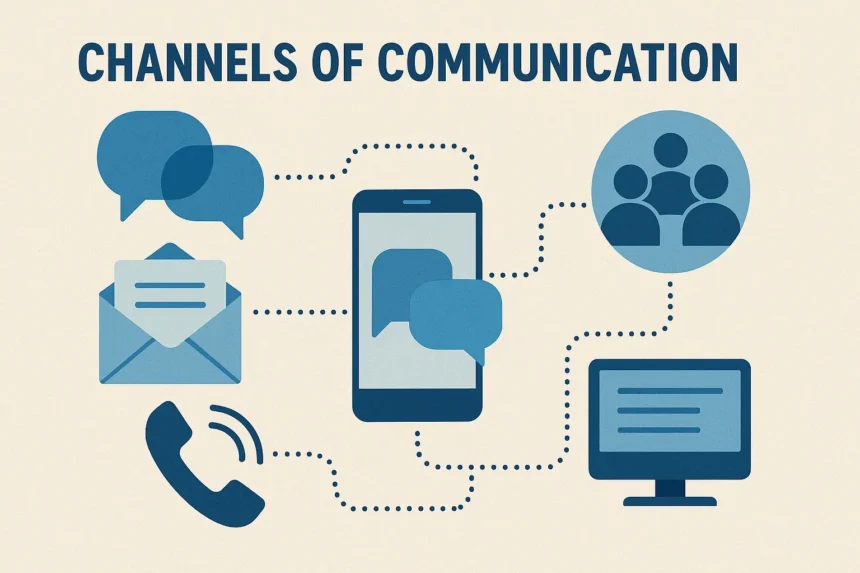Table of Contents
- What Are Channels of Communication
- Importance of Communication Channels in the Workplace
- Different Channels of Communication in the Workplace
- Examples of Effective Channels of Communication
- How to Choose the Right Communication Channel at Work
- Challenges in Communication Channels
- Best Practices to Improve Communication Skills
Channels of communication are the paths people use to share information in any setting. They are important because the right channel makes messages clearer and reduces chances of misunderstanding.
The main forms of communication channels include:
- Verbal communication
- Written communication
- Non-verbal communication
- Digital communication
Each of these plays a unique role in how people exchange ideas and understand one another. In the workplace, choosing the right channel can improve teamwork and make daily tasks more efficient.
In this blog, we will explain the different channels of communication used at work and share simple examples to show how they impact everyday interactions.
What Are Channels of Communication?
Channels of communication are the routes through which information moves between people. They act like bridges that connect a sender with a receiver so the message can be shared and understood.
Here are some common examples of channels of communication:
- Face-to-face conversations – feedback from a manager to an employee.
- Emails – HR sending an offer letter.
- Instant messaging – team chats during a project.
- Video meetings – weekly discussions with remote teams.
- Social media – company posts about new products.
Without a clear channel, the best ideas can get lost. This is why every interaction, big or small, depends on a chosen communication channel.
Importance of Communication Channels in the Workplace
The way you share information at work can decide how well people understand it. Picking the right channel makes communication clear and smooth, while the wrong one can cause delays and confusion.
- Makes the message easier to understand
- Encourages feedback and two-way interaction
- Matches the style of communication to the audience
- Prevents confusion and workplace misunderstandings
- Increases efficiency in daily tasks and projects
- Builds trust between managers, employees, and clients
- Creates a smoother workflow across teams
Different Channels of Communication in the Workplace
Workplaces depend on communication every day. The way a message travels matters as much as the message itself. That is why channels of communication are important. Each channel has its strengths, limits, and best uses. Let’s look at the four main types.
1. Verbal communication
Verbal communication uses spoken words. It is the oldest channel and still the most effective for building trust and solving problems. Here are the different types of verbal communication channels.
In-person conversations
Talking face-to-face allows people to ask questions and clear doubts immediately. It works well for sensitive topics or complex ideas. The challenge is that it only works when people are in the same location.
Example: A manager meets two employees to settle a workplace conflict before it gets worse.
Phone calls
Calls are fast and personal. They help when people are in different places but need quick answers. The drawback is that without facial expressions, the meaning can sometimes be misunderstood.
Example: A customer service agent calls a client to explain how to activate a product.
Video meetings
Video calls combine voice with visual cues. They are now common in remote work. They allow teams in different cities or countries to work together. However, they are reliant on good internet and can feel tiring if you use too often.
Example: A project team in 3 countries meets on Zoom every Monday to plan tasks.
2. Written Communication
Written channels use text. They can feel slower than speech but they are reliable when you require records or detailed instructions.
Emails
Emails are formal and widely used. They work best for announcements, updates, and messages that people may need later. The risk is that tone is easy to misread.
Example: HR sends an email to inform staff about a new leave policy.
Read More: How to Write a Formal Email
Also Read: What is Email Writing
Reports and memos
Reports and memos provide structured information. They act as a permanent reference for management and employees. The challenge is that they take time to prepare and may not work well for urgent tasks.
Example: A finance team prepares a budget report for the board.
Instant messaging
Platforms like Slack, Teams, or WhatsApp allow quick exchanges. They help with fast updates and coordination. Still, too many notifications can distract employees.
Example: A developer posts a quick note in Slack about fixing a bug.
3. Non-Verbal Communication
Non-verbal channels do not use words but still influence how people understand messages. They often add meaning to spoken or written words.
Body language and expressions
Gestures, posture, and facial expressions reveal feelings and attitudes. They can show confidence, doubt, or interest. Misunderstandings, however, are common.
Example: A candidate smiles and maintains eye contact in an interview to show confidence.
Tone and pauses
The way someone speaks changes meaning. A soft tone can calm others – while a sharp tone may create tension.
Example: A manager uses a calm tone while giving difficult feedback.
Visual aids
Charts and slides simplify complex information. They make presentations easier to follow. If overused, they can confuse the audience.
Example: A marketing manager uses a graph to show customer trends in a team meeting.
Read More: What is Non-Verbal Communication
Read More: How to Use Non-Verbal Communication in a Job Interview
4. Digital Communication
Digital channels use technology to share messages. They combine elements of other channels and allow fast and large-scale communication.
Social media platforms
LinkedIn, Twitter, or Facebook help businesses reach customers and build a brand. They are powerful but need careful handling to avoid mistakes.
Example: A company shares employee achievements on LinkedIn to attract talent.
Online forums and communities
Forums allow people to ask questions, share ideas and solve problems. They are helpful for technical industries but need moderation to stay helpful.
Example: A software company hosts a forum where users post coding solutions.
Websites and blogs
Websites act as information hubs – while blogs share insights and updates. They work well for knowledge sharing but need constant updates.
Example: A consulting firm posts monthly blogs about industry trends.
Examples of Effective Channels of Communication
The right channel depends on the situation. Here are 4 simple examples of how different channels of communication work best at workplace:
1. Instant messaging for quick problem-solving
A software team uses Slack to resolve a bug in real-time – preventing project delays.
2. Phone calls for urgent clarification
A sales rep calls the warehouse to confirm stock availability before he promises delivery to his client.
3. In-person check-ins for sensitive issues
A manager meets with an employee privately to discuss their performance concerns and to offer guidance.
4. Company intranet for shared resources
Employees log into the intranet to access HR forms, training guides and policy updates anytime.
How to Choose the Right Communication Channel at Work?
Picking the right channel depends on a few key factors. Here’s what you should think about before sharing any message:
Check urgency
Consider the urgency of the messages. If you want to communicate instantly, use instant messaging, calls, or even quick meetings. These channels remove delays and allow action right away.
Consider complexity
Not all channels of communication are suitable for complex messages. So, if the topic is detailed or technical, a written channel like email or reports works best. For short and simple updates, verbal or digital tools are enough.
Think about records
Another thing you must consider is the record of the message. For messages you might need later – go for written channels. Email or reports give you a permanent trail.
Audience preference
Think about who will receive the message. Senior staff may prefer formal updates in writing – while younger employees often respond better to quick chats or calls.
Formality level
Match the channel to the situation. Formal messages, like policy changes, should go out by email or documents. Informal updates can be shared face-to-face or through chat tools.
Need for feedback
If you need fast input or discussion, pick channels that allow real-time interaction such as video calls or phone conversations. For feedback that can wait, written formats are fine.
Read More: How to Use Communication Skills In an Interview
Challenges in Communication Channels
Even with many tools available, communication at work is not always smooth. Here are some common challenges employees and managers face:
- Miscommunication – Wrong choice of channel or unclear language can lead to confusion and errors.
- Lack of feedback – Some channels don’t allow instant replies – which delays decisions.
- Information overload – Too many emails, messages or meetings make it hard to focus on what is important.
- Accessibility issues – Not all employees may have equal access to digital avenues.
- Tone and intent – Written messages can be misread because they lack vocal or facial expressions.
- Technical problems – Poor internet or software issues disrupt video calls and digital platforms.
- Cultural differences – Non-verbal signals and communication styles vary across cultures, which can create misunderstandings.
Best Practices to Improve Communication Skills
Good communication skills don’t happen overnight. They grow with practice and by making small changes in how you share and receive information. Here are some best practices you can apply at work-
- Listen carefully without interrupting
- Match tone with the situation
- Keep your message simple and clear
- Pick the right channel for the message
- Ask for and accept feedback
- Use positive body language
- Show empathy in conversations
Read More: Ways to Improve Your Communication Skills Quickly
FAQs
What are communication channels used for?
Communication channels help employees share ideas, updates, and instructions. They keep teams aligned, reduce confusion, and make collaboration smoother across departments.
What’s the difference between verbal and non-verbal communication?
Verbal communication uses spoken or written words, like meetings, calls, or emails. Non-verbal communication relies on cues such as body language, tone, and facial expressions.
What are the five channels of communication?
The commonly discussed channels include verbal, written, non-verbal, digital, and visual communication. Each serves a different purpose depending on the message and situation.
What is a channel in communication?
A channel is the medium through which a message travels from sender to receiver. It can be speech, writing, visuals, or digital platforms.







